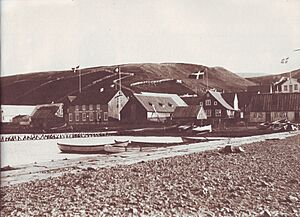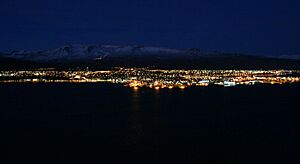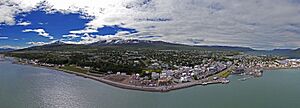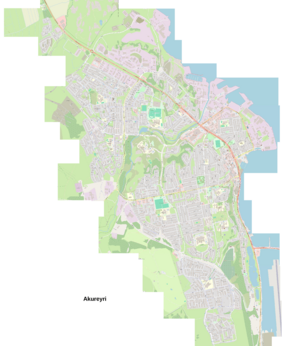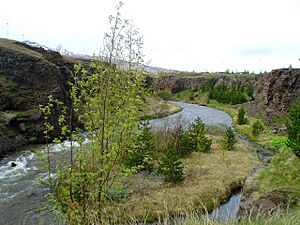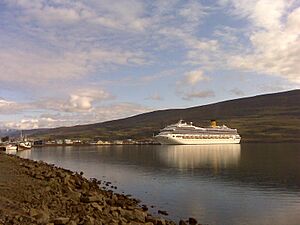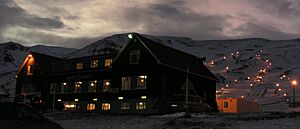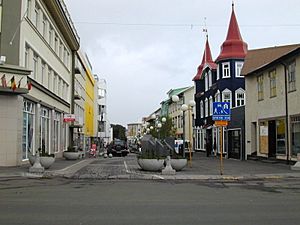Akureyri facts for kids
Quick facts for kids
Akureyri
|
||
|---|---|---|
|
Municipality
|
||

An aerial view of downtown Akureyri
|
||
|
||
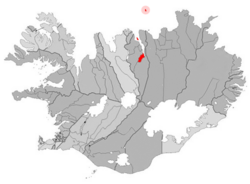
Location of the Akureyri Municipality
|
||
| Country | Iceland | |
| Region | Northeastern Region | |
| Constituency | Northeast Constituency | |
| Area | ||
| • Total | 138 km2 (53 sq mi) | |
| Population
(2021)
|
||
| • Total | 19,219 | |
| • Density | 131.82/km2 (341.4/sq mi) | |
| Postal code(s) |
600, 601, 602, 603, 611, 630
|
|
| Municipal number | 6000 | |
Akureyri is a town in northern Iceland. It is the country's fifth largest town and the biggest one outside the capital area. The official name for the town's local government is Akureyrarbær, which means 'town of Akureyri'.
Akureyri is often called the "Capital of North Iceland". It is a very important port and a center for fishing. People first settled in this area in the 800s. However, Akureyri only became an official town in 1786. During World War II, friendly forces were based here. The town grew a lot after the war as more people in Iceland moved to cities.
The area has a fairly mild climate because of its location. The town's harbor never freezes, which has been very important throughout its history.
Contents
- History of Akureyri
- Geography of Akureyri
- Climate in Akureyri
- Population of Akureyri
- How People Make a Living in Akureyri
- Culture and Fun in Akureyri
- Things to See and Do in Akureyri
- Twin Towns – Sister Cities
- Education in Akureyri
- Getting Around Akureyri
- How Akureyri Gets Power and Heat
- Sports in Akureyri
- See also
History of Akureyri
The first people to settle in this area were Norse Vikings in the 9th century. The town was first mentioned in official records in 1562. In the 1600s, Danish merchants set up trading posts here. They chose this spot because it had a great natural harbor and fertile land. These merchants did not live in Akureyri all year round; they went home for the winter.
People started living in Akureyri permanently in 1778. Eight years later, in 1786, the king of Denmark, Christian VII, gave Akureyri its official town status. He hoped this would help improve life for people in Iceland, as there were no big cities at the time. However, Akureyri did not grow much at first. It even lost its town status in 1836, but got it back in 1862. After that, Akureyri grew quickly because of its excellent port and the rich farming land nearby. Farming products became a big part of the town's economy.
During World War II, Akureyri was used as an air base by Norwegian and British forces. They flew planes to protect ships traveling between the United States, the United Kingdom, and Russia from German submarines. There was even a German plan, called Operation Ikarus, to invade Iceland, and Akureyri was one of the planned landing spots.
In the 20th century, many people in Iceland moved from the countryside to towns like Akureyri. Businesses and service jobs became the main types of work in the 1990s. Jón Sveinsson, a famous author of children's books, was born in Akureyri.
In the early 2000s, fishing companies became even more important to Akureyri's economy. The University of Akureyri was started in 1987 and has been growing fast.
Since 2004, the island of Hrísey has been part of Akureyri. Hrísey is about 35 kilometers (22 miles) north of Akureyri and has about 210 people. It is the second-largest island off Iceland.
Geography of Akureyri
Akureyri is located at the very end of a long fjord called Eyjafjörður. It sits on the west side of this fjord.
High mountains surround the town. The tallest ones are Strýta (1,451 meters or 4,760 feet high) and Kerling (1,538 meters or 5,046 feet high). The town itself has a narrow flat area along the coast, with a steep but low hill behind it. In the past, there were several small land points, called eyri in Icelandic, sticking out into the water. This is where the name Akureyri comes from. Today, much of the land has been built up, making the coastline smoother. The largest land point is Oddeyri, formed by the Glerá river that flows through the town.
The part of the sea between Oddeyri and the end of the fjord is called Pollurinn, which means "The Pool." It's known for calm winds and a great natural harbor. Today, Akureyri's center is around Ráðhústorg (Town Hall Square). The town has different areas: Innbær (the oldest part), Brekkan (on top of the hill), Oddeyri (on the peninsula), and Glerárhverfi (on the north side of the Glerá river).
Because Akureyri is at the end of a long fjord and surrounded by tall mountains, its climate is more like an inland area than a coastal one. This means it has bigger temperature changes, with warmer summers and colder winters. However, the mountains also protect the town from strong winds. The climate is quite warm for how far north it is, allowing the botanical gardens to grow well without needing a greenhouse. Akureyri is only about 100 kilometers (62 miles) from the Arctic Circle.
Climate in Akureyri
Akureyri has cold winters and mild summers. Snow usually starts in late October and melts by April. However, snow can stay on the mountain peaks around Akureyri all year. Akureyri is a very cloudy town, especially from November to February, partly because it's so close to the Arctic Circle. But it gets much less rain than southern Iceland because the winds usually come from the south.
Population of Akureyri
As of 2021, Akureyri has a population of 19,219 people. About 3% of the people living here are from other countries, coming from 53 different places. In 2014, there were 229 births and 118 deaths in Akureyri. More people moved into the town than moved out, so the population grew by 0.5% that year. The population has grown a lot over time: in 1910, there were 2,239 people, and by 2005, there were 16,756.
How People Make a Living in Akureyri
The fishing industry has always been a very important part of Akureyri's economy. In recent years, other types of businesses and services have also grown. Education, especially at the university level, is also becoming a bigger part of the local economy. About 20% of the people who work in Akureyri are in the service industry.
Two of Iceland's five largest fishing companies have their main offices in Akureyri. This is partly because the harbor never freezes. Other big companies in Akureyri include Samherji, Norðurmjólk, Brim hf, and Vífilfell, which is the biggest brewery in Iceland. The Akureyri Hospital (Sjúkrahús Akureyrar) is also a major employer in the area.
Culture and Fun in Akureyri
Akureyri has a lively cultural scene with many restaurants and bars. The Icelandic folk dance group "Vefarinn" is from Akureyri. Folk culture is very popular here. In the summer, several festivals take place in Akureyri and nearby. For example, there's a medieval festival held every summer at Gásir. The Akureyri International Music Festival, which features many bands, is also held here. The town also has one of the largest libraries in Iceland.
Media
The Vikudagur newspaper is published in Akureyri. The Icelandic National Broadcasting Service has two radio channels that reach the whole country. Akureyri also has its own local radio stations like FM Akureyri and Voice FM 98.7. There are several TV stations you can watch. N4 is a TV station with studios in Akureyri. It started as a local channel but began broadcasting nationwide in 2008.
Things to See and Do in Akureyri
Akureyri has many interesting places to visit. These include various museums, churches, and the Botanical Gardens. Some local museums are the Akureyri Museum, the Akureyri Art Museum, Nonnahús (Nonni house, dedicated to the writer Jón Sveinsson), Davíðshús (David's house, for the poet Davíð Stefánsson), the Akureyri Museum of Industry, a motorcycle museum, and Flugsafn Íslands (Aviation Museum of Iceland). The town also has the world's most northerly 18-hole golf course.
The Nature Museum (Náttúrufræðistofnun Norðurlands) opened in 1957 and is located in the Akureyri Botanical Garden. The Botanical Gardens (Lystigarður Akureyrar) are on Spítalavegur street. Important churches include the Akureyrarkirkja (the Church of Akureyri) and Glerárkirkja (the Church of Glerá). Sundlaug Akureyrar is a popular swimming pool in Akureyri.
As the town grows, new homes and businesses need more electricity and water. Much of the town is heated using geothermal energy, which comes from the Earth's heat.
Twin Towns – Sister Cities
Akureyri has special friendly connections with these towns and cities around the world. In 2007, Akureyri also signed a friendship agreement with Grimsby, United Kingdom, which might become a twin city in the future.
Education in Akureyri
Akureyri has two high schools. One of them, Menntaskólinn á Akureyri (MA), is the second oldest high school in Iceland and focuses on academic studies. The newer school, Verkmenntaskólinn á Akureyri (VMA), offers both academic and job-training studies. The University of Akureyri (Háskólinn á Akureyri) was started in 1987. It has three main departments: Business and Science, Humanities and Social Sciences, and Health Sciences. The university offers master's degrees in many subjects.
Getting Around Akureyri
Airport

Akureyri Airport is one of four international airports in Iceland. It is the only international airport in the northern part of the country. It was built in 1954.
The airport is mostly used for flights within Iceland. Icelandair flies several times a day to Reykjavík. There are also domestic flights to smaller places like Grímsey, Vopnafjörður, and Þórshöfn in northeast Iceland.
During certain seasons, there are also international flights to London-Gatwick, Amsterdam, and Zürich with airlines like easyJet and Transavia. You can also fly to Nerlerit Inaat in Greenland from here.
In 2007, Akureyri Airport had over 221,200 passengers and nearly 20,000 aircraft movements.
Marine Port
The port of Akureyri is very important for the town because fishing is a big part of its economy. It has large fish processing factories and places for fishing boats to dock. The port is also important for moving goods and for tourism, as many cruise ships visit Akureyri during the summer. The fact that the port does not freeze in winter has been key to the town's success.
Bus
Local bus services in Akureyri are run by the SVA (Akureyri Bus Company). The best part is that they do not charge fares! When they stopped charging fares in 2008, the number of passengers increased by 130% compared to the year before.
Roads
Route 1, also known as the Ring Road, connects Akureyri to other parts of Iceland, including Reykjavík, which is about 390 kilometers (242 miles) away. This road usually has one lane in each direction, but it is paved and open all year. The Vaðlaheiðargöng tunnel is just east of Akureyri on Route 1. It opened in December 2018 and makes the drive from Akureyri to Mývatn lake 16 kilometers (10 miles) shorter. It is currently Iceland's only toll road, meaning you have to pay to use it.
Parking in the town center costs money as of 2023, with different prices in two zones.
The F821 mountain road goes south from Akureyri and connects to the F26 mountain road, which crosses the highlands. This road is only open during the summer.
How Akureyri Gets Power and Heat
Akureyri has been heated using geothermal energy since the late 1970s. Geothermal energy uses heat from inside the Earth. Before that, electricity and oil were used for heating. Construction of the geothermal heating system began in 1976 after a good source of geothermal water was found in 1975. By 1979, most of the town was using this heating system.
The Laugaland area near Akureyri was the first place where geothermal energy was used for heating. Other areas were developed later to get enough hot water. The water temperature is usually between 65 to 75 degrees Celsius (149 to 167 degrees Fahrenheit).
Sports in Akureyri
Knattspyrnufélag Akureyrar (KA) and Þór Akureyri are the two biggest sports clubs in town. They have teams in many sports, like basketball, football, and handball.
The most successful women's football team recently has been Þór/KA, which is a combined team from KA and Þór. They have finished in the top four in the main league since 2008 and won the national championship in 2012 and 2017. The clubs also have their own men's football teams.
In women's handball, the clubs have a combined team called KA/Þór. In basketball, Þór has both men's and women's teams. Their women's team has won the national championship three times: in 1969, 1971, and 1976.
The town's ice hockey team, Skautafélag Akureyrar, is the most successful team in the history of the Icelandic Hockey League. They have won 20 championships between 1992 and 2018.
The Akureyri Golf Club is the second oldest golf club in Iceland. It was started in 1935 and hosts The Arctic Open golf tournament every summer. Akureyri is also the birthplace of famous Icelandic footballers Birkir Bjarnason and Aron Gunnarsson, and mixed martial arts fighter Gunnar Nelson.
See also
 In Spanish: Akureyri para niños
In Spanish: Akureyri para niños



